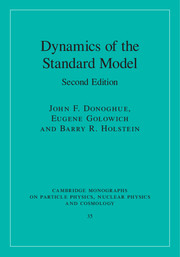Book contents
- Frontmatter
- Dedication
- Contents
- Preface to the second edition
- I Inputs to the Standard Model
- II Interactions of the Standard Model
- III Symmetries and anomalies
- IV Introduction to effective field theory
- V Charged leptons
- VI Neutrinos
- VII Effective field theory for low-energy QCD
- VIII Weak interactions of kaons
- IX Mass mixing and CP violation
- X The N−1c expansion
- XI Phenomenological models
- XII Baryon properties
- XIII Hadron spectroscopy
- XIV Weak interactions of heavy quarks
- XV The Higgs boson
- XVI The electroweak sector
- Appendix A Functional integration
- Appendix B Advanced field-theoretic methods
- Appendix C Useful formulae
- References
- Index
IV - Introduction to effective field theory
- Frontmatter
- Dedication
- Contents
- Preface to the second edition
- I Inputs to the Standard Model
- II Interactions of the Standard Model
- III Symmetries and anomalies
- IV Introduction to effective field theory
- V Charged leptons
- VI Neutrinos
- VII Effective field theory for low-energy QCD
- VIII Weak interactions of kaons
- IX Mass mixing and CP violation
- X The N−1c expansion
- XI Phenomenological models
- XII Baryon properties
- XIII Hadron spectroscopy
- XIV Weak interactions of heavy quarks
- XV The Higgs boson
- XVI The electroweak sector
- Appendix A Functional integration
- Appendix B Advanced field-theoretic methods
- Appendix C Useful formulae
- References
- Index
Summary
The purpose of an effective field theory is to represent in a simple way the dynamical content of a theory in the low-energy limit. One uses only those light degrees of freedom that are active at low energy, and treats their interactions in a full field-theoretic framework. The effective field theory is often technically non-renormalizable, yet loop diagrams are included and renormalization of the physical parameters is readily accomplished.
Effective field theory is used in all aspects of the Standard Model and beyond, from QED to superstrings. Perhaps the best setting for learning about the topic is that of chiral symmetry. Besides being historically important in the development of effective field theory techniques, chiral symmetry is a rather subtle subject, which can be used to illustrate all aspects of the method, viz., the low-energy expansion, non-leading behavior, loops, renormalization and symmetry breaking. In addition, the results can be tested directly by experiment since the chiral effective field theory provides a framework for understanding the very low-energy limit of QCD.
In this chapter we introduce effective field theory by a study of the linear sigma model, and discuss the generalization of these techniques to other settings.
Effective lagrangians and the sigma model
The linear sigma model, introduced in Sects. I–4, I–6, provides a ‘user friendly’ introduction to effective field theory because all the relevant manipulations can be explicitly demonstrated. The Goldstone boson fields, the pions, are present at all stages of the calculation. It also introduces many concepts which are relevant for the low enegy limit of QCD.
- Type
- Chapter
- Information
- Dynamics of the Standard Model , pp. 106 - 143Publisher: Cambridge University PressPrint publication year: 2014



